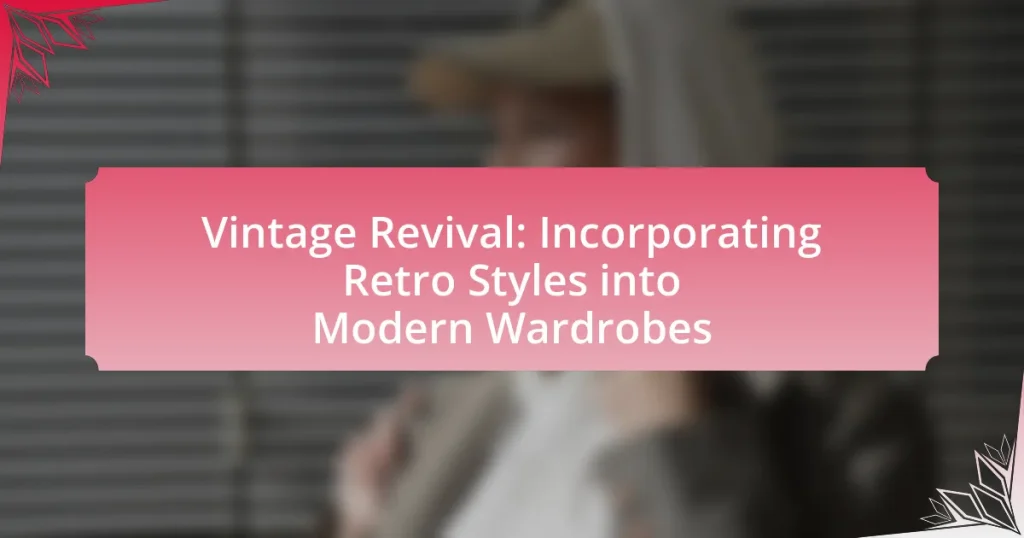The article focuses on the concept of a Capsule Wardrobe, which is a curated collection of 30 to 40 essential clothing items designed for versatility and minimalism. It outlines the differences between a Capsule Wardrobe and a traditional wardrobe, emphasizing the benefits of intentional purchasing, reduced decision fatigue, and sustainable fashion practices. Key characteristics include a limited selection of high-quality pieces, a cohesive color palette, and strategies for selecting versatile items for each season. The article also provides practical steps for building and maintaining a Capsule Wardrobe, budgeting effectively, and avoiding common mistakes, ensuring a functional and stylish wardrobe throughout the year.

What is a Capsule Wardrobe?
A capsule wardrobe is a curated collection of essential clothing items that can be mixed and matched to create a variety of outfits. This concept promotes minimalism and efficiency in fashion, allowing individuals to streamline their wardrobe while maintaining style versatility. The idea originated in the 1970s, popularized by designer Susie Faux, who emphasized the importance of quality over quantity in clothing choices. A typical capsule wardrobe consists of around 30 to 40 pieces, including tops, bottoms, outerwear, and shoes, which can be adapted for different seasons and occasions.
How does a Capsule Wardrobe differ from a traditional wardrobe?
A Capsule Wardrobe differs from a traditional wardrobe primarily in its size and focus on versatility. A Capsule Wardrobe typically consists of a limited number of essential, high-quality pieces that can be mixed and matched to create various outfits, whereas a traditional wardrobe often contains a larger variety of items, including many that may not coordinate well together. This streamlined approach in a Capsule Wardrobe promotes intentionality in clothing choices, reducing decision fatigue and encouraging sustainable fashion practices. Studies indicate that individuals with Capsule Wardrobes report higher satisfaction with their clothing choices and reduced clutter, highlighting the effectiveness of this method in contrast to traditional wardrobes.
What are the key characteristics of a Capsule Wardrobe?
A Capsule Wardrobe is characterized by a limited selection of versatile clothing items that can be mixed and matched to create various outfits. This approach emphasizes quality over quantity, focusing on timeless pieces that suit the individual’s style and lifestyle. Typically, a Capsule Wardrobe consists of around 30 to 40 items, including tops, bottoms, outerwear, and shoes, allowing for easy coordination and reduced decision fatigue. The concept promotes sustainability by encouraging mindful consumption and reducing the frequency of new purchases, aligning with eco-friendly practices in fashion.
Why is a Capsule Wardrobe beneficial for shopping smart?
A Capsule Wardrobe is beneficial for shopping smart because it promotes intentional purchasing and reduces impulse buys. By curating a limited selection of versatile clothing items, individuals can focus on quality over quantity, ensuring that each piece complements others in their wardrobe. This strategy not only saves money but also minimizes clutter and enhances personal style. Research indicates that consumers who adopt a Capsule Wardrobe approach tend to make more thoughtful decisions, leading to a more sustainable and efficient shopping experience.
What are the essential components of a Capsule Wardrobe?
The essential components of a Capsule Wardrobe include versatile clothing items that can be mixed and matched, a limited color palette, and a focus on quality over quantity. A Capsule Wardrobe typically consists of around 30 to 40 pieces, including tops, bottoms, outerwear, and shoes, designed to create a cohesive style. This approach emphasizes timeless pieces that transcend seasonal trends, allowing for easy outfit creation and reducing decision fatigue. The concept is supported by the minimalist fashion movement, which advocates for a simplified lifestyle and sustainable consumption.
How do you select versatile pieces for each season?
To select versatile pieces for each season, prioritize items that can be layered and styled in multiple ways. Versatile pieces should include neutral colors and classic silhouettes that can transition between casual and formal settings. For example, a tailored blazer can be worn over a t-shirt for a casual look or paired with a dress shirt for a more polished appearance. Additionally, fabrics that are breathable yet warm, such as cotton blends for spring and fall, or lightweight wool for winter, enhance adaptability. Research indicates that a well-curated capsule wardrobe, consisting of around 30 essential pieces, can significantly reduce decision fatigue and increase outfit variety, making it easier to dress appropriately for any occasion throughout the year.
What role do colors and patterns play in a Capsule Wardrobe?
Colors and patterns in a Capsule Wardrobe serve to create a cohesive and versatile collection of clothing that can be easily mixed and matched. A well-chosen color palette allows for greater outfit combinations while ensuring that each piece complements the others, enhancing the overall aesthetic. For instance, neutral colors like black, white, and beige provide a solid foundation, while accent colors can add personality and style. Patterns, when used sparingly, can introduce visual interest without overwhelming the wardrobe. Research indicates that a limited color scheme can simplify decision-making and reduce wardrobe fatigue, making it easier for individuals to dress efficiently.

How to Build a Capsule Wardrobe for Each Season?
To build a capsule wardrobe for each season, start by selecting a limited number of versatile clothing pieces that can be mixed and matched. For spring, include lightweight layers such as a trench coat, breathable tops, and versatile bottoms like chinos or skirts. In summer, focus on breathable fabrics, incorporating items like sundresses, shorts, and sandals. For fall, choose warmer layers such as sweaters, long-sleeve shirts, and ankle boots. In winter, prioritize insulation with items like a warm coat, thermal tops, and sturdy boots. This approach allows for a cohesive wardrobe that minimizes clutter while maximizing outfit options, aligning with the principles of minimalism and intentional shopping.
What steps should you follow to create a seasonal Capsule Wardrobe?
To create a seasonal Capsule Wardrobe, follow these steps: first, assess your current wardrobe to identify items you love and wear frequently. Next, determine the key pieces needed for the upcoming season based on your lifestyle and climate. Then, select versatile clothing items that can be mixed and matched, focusing on a cohesive color palette. After that, limit the number of pieces to around 25-40 items, including tops, bottoms, outerwear, and shoes. Finally, evaluate your selections to ensure they reflect your personal style and meet your functional needs. This method is effective as it promotes mindful shopping and reduces clutter, aligning with the principles of minimalism and sustainable fashion.
How do you assess your current wardrobe before building a Capsule Wardrobe?
To assess your current wardrobe before building a Capsule Wardrobe, start by evaluating each item for its versatility, fit, and condition. This involves categorizing clothing into keep, donate, or discard piles based on how often you wear them and whether they align with your personal style and lifestyle needs. Research indicates that individuals typically wear only 20% of their wardrobe 80% of the time, highlighting the importance of this assessment process. By identifying key pieces that can be mixed and matched, you ensure that your Capsule Wardrobe is functional and reflective of your preferences.
What criteria should you use to choose seasonal items?
To choose seasonal items effectively, prioritize versatility, quality, and alignment with current trends. Versatility ensures that each piece can be styled in multiple ways, maximizing outfit combinations. Quality is crucial as it affects the longevity and appearance of the items, with well-made pieces often providing better value over time. Additionally, selecting items that align with current trends helps maintain a modern and stylish wardrobe. For instance, a study by the Fashion Institute of Technology highlights that consumers who invest in versatile and high-quality clothing tend to have a more sustainable wardrobe, reducing the need for frequent replacements.
How can you ensure your Capsule Wardrobe remains functional throughout the season?
To ensure your Capsule Wardrobe remains functional throughout the season, regularly assess and rotate items based on weather changes and personal needs. This involves evaluating the versatility of each piece, ensuring they can be mixed and matched effectively, and replacing any items that no longer fit or serve a purpose. Research indicates that a well-curated Capsule Wardrobe can reduce decision fatigue and enhance outfit coordination, making it easier to adapt to seasonal shifts.
What strategies can you use to mix and match items effectively?
To mix and match items effectively, focus on creating a cohesive color palette and selecting versatile pieces. A cohesive color palette allows for easy pairing of items, ensuring that colors complement each other. For instance, neutral colors like black, white, and beige can serve as a foundation, while adding a few accent colors can enhance variety without overwhelming the wardrobe. Selecting versatile pieces, such as a classic white shirt or a tailored blazer, enables multiple outfit combinations, maximizing the utility of each item. Research indicates that a well-curated capsule wardrobe can reduce decision fatigue and increase outfit satisfaction, as noted in the study “The Capsule Wardrobe: A Practical Guide” by fashion expert Jennifer Adams.
How do you adapt your Capsule Wardrobe for changing weather conditions?
To adapt a Capsule Wardrobe for changing weather conditions, incorporate versatile layering pieces that can be added or removed as temperatures fluctuate. For instance, include lightweight cardigans, long-sleeve shirts, and scarves that can easily transition from warm to cool weather. Additionally, select fabrics that are breathable for warmer days and insulating for cooler temperatures, such as cotton for summer and wool for winter. This approach allows for flexibility and comfort, ensuring that the wardrobe remains functional throughout varying climates.

What are the best practices for shopping smart while building a Capsule Wardrobe?
The best practices for shopping smart while building a Capsule Wardrobe include defining a clear list of essential items, prioritizing quality over quantity, and focusing on versatile pieces that can be mixed and matched. By identifying key wardrobe staples, such as a classic white shirt, tailored trousers, and a little black dress, individuals can streamline their shopping process and avoid impulse purchases. Research indicates that investing in high-quality materials leads to longer-lasting garments, reducing the need for frequent replacements. Additionally, selecting items that complement each other enhances outfit combinations, maximizing the utility of each piece. This strategic approach not only saves money but also fosters a more sustainable fashion practice.
How can you budget effectively for your Capsule Wardrobe?
To budget effectively for your Capsule Wardrobe, start by determining a specific budget amount based on your financial situation and clothing needs. This budget should account for essential pieces that align with your personal style and seasonal requirements. Research indicates that a well-planned Capsule Wardrobe can consist of 30 to 40 versatile items, allowing for a mix-and-match approach that reduces the need for excessive spending. By prioritizing quality over quantity, you can invest in durable, timeless pieces that will last longer, ultimately saving money in the long run. Additionally, tracking your purchases and setting limits for each category, such as tops, bottoms, and accessories, can help maintain adherence to your budget.
What tips can help you avoid impulse buying?
To avoid impulse buying, create a shopping list before you go shopping and stick to it. This strategy helps you focus on necessary items, reducing the likelihood of purchasing unplanned products. Research indicates that consumers who use shopping lists are less likely to make impulse purchases, as they have a clear plan and purpose for their shopping trip. Additionally, setting a budget and adhering to it can further minimize the temptation to buy items that are not essential, reinforcing disciplined spending habits.
How do you prioritize quality over quantity in your purchases?
To prioritize quality over quantity in purchases, focus on selecting fewer items that are well-made and versatile. This approach ensures that each piece contributes significantly to your wardrobe, enhancing its overall value and longevity. For instance, investing in high-quality fabrics and timeless designs can lead to a more sustainable wardrobe, as these items tend to last longer and withstand trends. Research indicates that consumers who prioritize quality often experience greater satisfaction and reduced long-term costs, as they buy less frequently and avoid the need for replacements.
What common mistakes should you avoid when building a Capsule Wardrobe?
When building a Capsule Wardrobe, common mistakes to avoid include not defining a clear personal style, which can lead to purchasing items that do not align with one’s preferences. Additionally, failing to consider versatility in clothing choices can result in a lack of outfit combinations, limiting the wardrobe’s effectiveness. Overlooking the importance of quality over quantity often leads to buying cheaper items that wear out quickly, undermining the capsule concept. Lastly, neglecting to regularly assess and update the wardrobe can cause it to become outdated or misaligned with current lifestyle needs.
How can you prevent overcomplicating your Capsule Wardrobe?
To prevent overcomplicating your Capsule Wardrobe, focus on selecting versatile, high-quality pieces that can be mixed and matched easily. By limiting your wardrobe to a specific number of items, typically between 30 to 40, you simplify choices and enhance outfit combinations. Research indicates that a streamlined wardrobe reduces decision fatigue, allowing for quicker outfit selection and increased satisfaction with daily choices.
What should you do if you find gaps in your Capsule Wardrobe?
If you find gaps in your Capsule Wardrobe, you should identify the specific items needed to complete your collection. Assess your current wardrobe to determine which essential pieces are missing, such as versatile tops, bottoms, or outerwear that align with your style and lifestyle. Research indicates that a well-rounded Capsule Wardrobe typically includes a limited number of essential items that can be mixed and matched, making it crucial to fill in any gaps with quality pieces that enhance versatility and functionality.
What are some practical tips for maintaining a Capsule Wardrobe?
To maintain a Capsule Wardrobe effectively, regularly assess and curate your clothing collection by removing items that no longer fit or are not worn. This practice ensures that only versatile, high-quality pieces remain, which can be mixed and matched easily. Additionally, establish a seasonal review schedule, ideally every three months, to adapt your wardrobe to changing weather and trends, ensuring relevance and functionality. Keeping a list of essential items helps in identifying gaps and preventing unnecessary purchases, thus promoting mindful shopping. Lastly, invest in proper storage solutions to protect your garments, which extends their lifespan and maintains their appearance.














